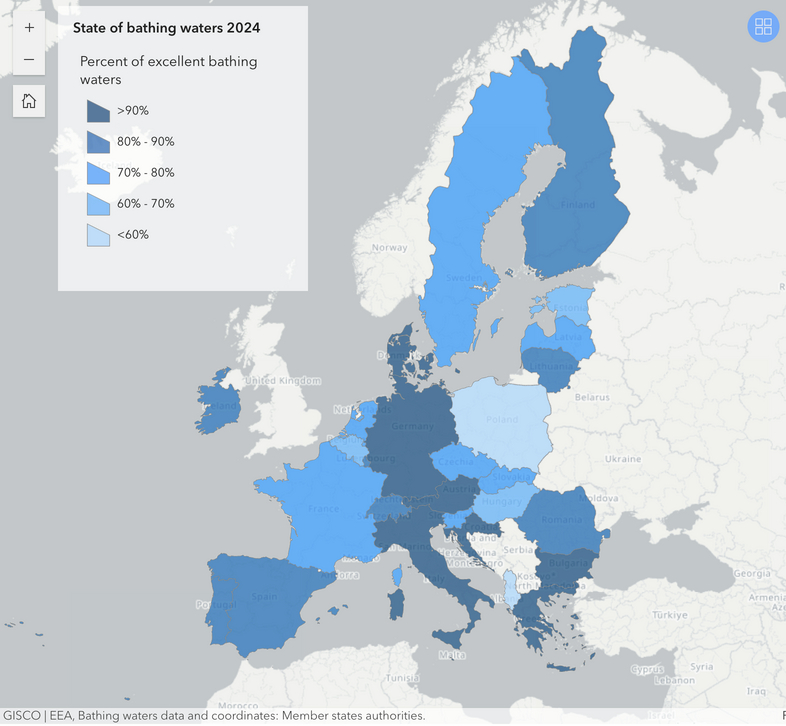REVEALED: Where in Europe has the cleanest and dirtiest swimming spots

Europe has thousands of incredible swimming spots around its beaches, lakes and rivers, but which countries have the cleanest and dirtiest waters?
More than three quarters of bathing waters monitored in the European Union, Albania and Switzerland were of "excellent" quality in 2024, the 27-member bloc's environment agency said on Friday.
All but four percent met the EU's minimum standard ("sufficient") and just 1.5 percent were of "poor" quality, the European Environment Agency said in its annual update on the beaches, rivers and lakes that are tested for faecal contamination.
Overall, Europe's bathing waters were of the same standard in 2024 as in the year before.
The EEA monitors more than 22,000 bathing areas for bacteria such as Escherichia coli (E. coli) and intestinal enterococci, caused essentially by pollutant run-off from livestock farms and household sewage pipes.
"Europeans can confidently bathe in the vast majority of the EU's bathing sites that meet the EU's bathing quality standards," European Environment Commissioner Jessika Roswall said.
The best bathing waters last year were in Cyprus, where 99.2 percent were of excellent quality, followed by Bulgaria with 97.9 percent, Greece with 97, Austria with 95.8 and Croatia with 95.2.
Other countries covered by The Local also featured in the top 10 of the EU's cleanest waters: Denmark was in sixth place with 92.9 percent of its water found to be of excellent quality. Germany was a little lower in eighth place with 90.5, closely followed by Italy with 90.2 and Spain with 87.6.
Swiss bathing water quality falls below EU average
Switzerland was a little further down the rankings with 83.1 percent of its waters deemed to be of excellent quality last year, down over eight percentage points on 2023. Closer to the bottom of the list were France and Sweden, with 74.2 and 73.5 percent, respectively.
The EU-wide average was 85 percent.
 This EEA map shows bathing water quality across Europe in 2024
This EEA map shows bathing water quality across Europe in 2024Albania came bottom in the ranking, with just 16 percent of excellent quality bathing waters -- a drop of more than 25 percentage points over the space of a year.
In general, beaches were cleaner than rivers and lakes because of seawater's better capacity for renewal.
Many of central Europe's inland bathing areas are found in relatively small lakes, ponds and rivers, which are more susceptible than coastal areas to short-term pollution caused by heavy rains, the EEA said.
The agency said climate change was expected to increase the intensity and frequency of various extreme weather events, including heavy rains.
"In turn, these events will impact bathing water quality through pollution from sewer overflows, floods or surface run-off.
"This will come with corresponding potential increased health risks for bathers," it said on its website.
The EEA no longer collates data on bathing water in the UK, which left the bloc.
But the national Environment Agency found that in 2024, just 64.2 percent of England's bathing waters were "excellent" and 8.2 percent failed to meet the minimum standard and were classified as "poor".
British water companies, privatised since 1989, have repeatedly come under fire for allowing the discharge of large quantities of sewage into rivers and the sea.
More than 3 percent of waters 'poor' in France and Sweden
EU members meanwhile are obliged to monitor popular bathing places from May to September and rank the water quality as excellent, good, sufficient or poor.
In four European countries – Estonia, Sweden, the Netherlands and France – water quality was poor at 3 percent or more of bathing waters last year.
But of the 321 bathing sites that were recorded as poor in 2023, a fifth had improved by last year.
This includes Sweden, which had 19 sites (4 percent), five fewer than in 2023, that fell into this category.
France, however, had 16 more poor bathing areas in 2024 than the year before at 115 (3.4 percent), driven largely by a drop in water quality in its rivers.
When waters are found to be poor, authorities must shut the area to bathers the following year and take steps to reduce pollution and health hazards before they can re-open.
thelocal





